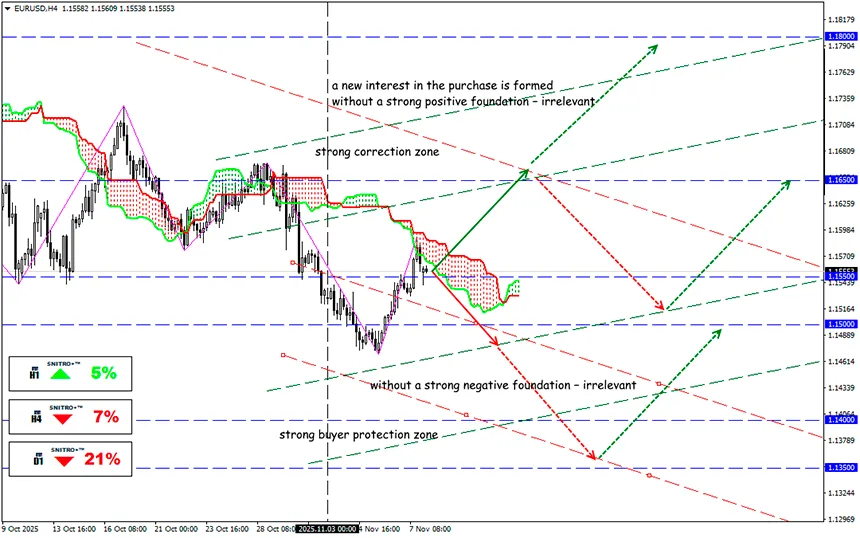Shutdown as a Weapon of Blackmail

How Low Liquidity Kills the Market
EUR/USD
Key zone: 1.1500 - 1.1600
Buy: 1.1650 (on a pullback after retesting the 1.1550 level) ; target 1.1800-1.1850; StopLoss 1.1580
Sell: 1.1500 (on strong negative fundamentals) ; target 1.1350-1.1300; StopLoss 1.1570
The main driver of panic and risk aversion remains the U.S. government shutdown. The liquidity shortage last week crashed the crypto market and stock indices while triggering an abnormal dollar rally.
On Friday, the Federal Reserve was forced to intervene by lowering the SOFR rate. A statement from John Williams, head of the New York Fed, announcing that the Fed would resume short-term U.S. Treasury bond purchases to manage banking reserves, immediately accelerated the dollar’s decline. Against this backdrop, Bitcoin tested a new local bottom, and the stock market closed the week in negative territory.
However, there are still no details regarding the timing and scale of Fed operations, which heightens market anxiety.
It’s worth noting that liquidity shortages existed even before the shutdown due to multiple factors — from Fed policy to capital outflows triggered by Trump’s trade measures — but the situation has now worsened dramatically. The U.S. Treasury continues collecting taxes but is not releasing funds back into the real economy; currently, more than $200 billion remains “frozen.”
The longer the shutdown lasts, the more risks it poses for both the real economy and the U.S. stock market. Millions of people are not receiving salaries or social benefits; businesses tied to government programs are suffering — all of this affects consumer spending, which for years has been the main driver of U.S. GDP growth.
The risk of a transportation collapse is rising: if the government doesn’t reopen by Thanksgiving (November 27), the country could face a major economic disaster.
In the Senate, a bipartisan compromise is being fought over, but the sides remain far apart:
- Trump categorically refuses to extend the Obamacare program, accusing it of inflating budget spending and enriching insurance corporations.
- Democrats insist that any concession to Trump would mean the rollback of healthcare benefits.
- On Friday, they proposed an alternative bill — to extend healthcare tax benefits for one year in exchange for restoring government operations.
- Trump, meanwhile, is exploring new healthcare reform schemes, including payments to citizens for purchasing private insurance using tariff revenues.
- Yesterday, despite the public holiday, both houses of Congress held active consultations. Insider reports suggest Trump is seeking to end the shutdown as soon as possible.
- Rumors suggest Republicans may threaten Democrats with the abolition of the filibuster to push a budget vote through a simple majority (60 out of 100 votes).
The fact that Republicans have entered negotiations increases the likelihood of a compromise this week. Markets are waiting for the Fed’s next moves and the outcome of Congressional talks.
The Federal Reserve appears ready to temporarily support the system with liquidity to mitigate the shutdown’s consequences, but this step will only stabilize the situation temporarily — it won’t solve the core problem: political deadlock. And although Trump is not interested in a financial crisis before the 2026 midterm elections, his pressure strategy on Democrats puts the entire market at risk.
After the shutdown ends, a Christmas rally seems logical — but one more problem remains.
Legal experts believe there is an 80% chance the U.S. Supreme Court will rule against Trump’s tariffs introduced under “national security” grounds. The administration is preparing new tariff orders, and markets are likely to remain nervous for at least two more weeks.
If the shutdown continues through late November, the consequences for domestic demand and the interbank market could become irreversible.
A new threat is also emerging on the horizon: legal experts predict an 80% probability that the U.S. Supreme Court will declare Trump’s tariffs illegal, as they were introduced bypassing Congress under the guise of national security. The White House is already preparing a new package of trade executive orders, adding another few months of instability and speculation to the market.
Ending the shutdown would inject liquidity — leading to a stock market rebound, crypto growth, dollar weakening, and setting the stage for a full-fledged Christmas rally.
So we act wisely and avoid unnecessary risks.
Profits to y’all!








